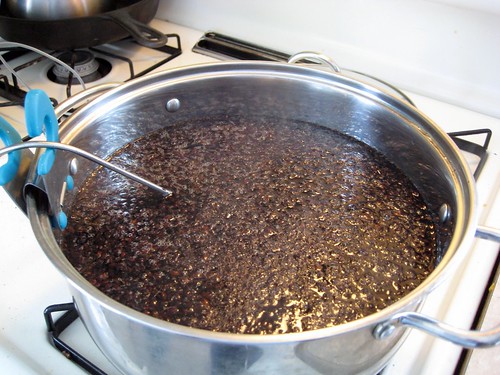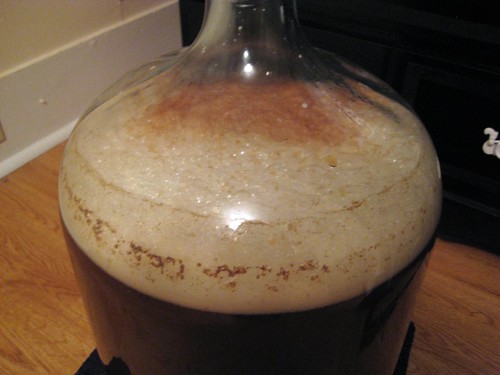 |
| The malt steeping |
The beer was a lot easier than I'd expected, but I was expecting it to be a big hassle. Maybe other recipes will be. We have sanitizing down pat: bleach everything, rinse it well.
For the ciders and wines I've done before, prep is just a matter of boiling everything that will go into the carboy long enough to pasteurize it, and then wait for it to cool down enough before adding the yeast so it won't kill the yeast. For the beer we first steeped the malted barley at 120 for 20 minutes, like making barley tea, then removed the grain and steeped the must (the barley tea) with part of the hops. Then more hops went in for a short to bitter it. One step of hops imparts preservative chemicals from the hops, the other is the flavor step.
When all the hops were taken out (we used a pellet form of hops and steeped them inside a big tea bag kept for the purpose), that pot-full went into the carboy, which was sitting on a towel to keep the temperature difference between the hot liquid and the cold floor from cracking the glass. Ideally, if we had a bigger pot, we'd have boiled the malt extract syrup together with the malt and the hops, but our biggest pot is only one gallon and barely held one can of syrup and the water it took to thin it out a little. So each can of syrup was boiled with water separately, put in the carboy, and then the whole thing was topped off with cold distilled water to bring the temperature down.
When brewing anything, you're supposed to use a special measure called a hydrometer to measure the sugar content of the must to a. tell you how much will or has converted to alcohol, and b. to tell you when fermentation is complete. It does this by measuring the density of the must relative to water, and when it doesn't change for a couple of days, it means fermentation is complete. You're supposed to have a specific vial which comes with your hydrometer that the must is poured into, and the hydrometer floated in, but I inherited my hydrometer from my parents sans vial. So we had a bit of a scramble looking for something to measure it in and ended up having a flower vase filled up with a lot of pre-beer.
We did all this in the kitchen, since that was close to the stove and pots of hot must, but the yeast is supposed to ferment below 65 degrees, so J hauled the very heavy carboy into our very cold guest bedroom where we'd closed all the vents off. Now it's waiting, burping out carbon dioxide through its airlock and building up unfermentable resins at the top of the carboy, and getting ready to be delicious.

That looks delicious. J doesn't drink, but maybe I could convince him it's a science experiment to make it for me.
ReplyDeleteI remember you said a while ago that J does non-alcoholic ferments . . . does he do soda? I've known people who've made homemade soda, carbonated with CO2 from the same yeast that makes beer and champagne, but the brewing process doesn't make alcohol because it doesn't ferment as long. I've never done it, but it's supposed to be the same process.
ReplyDeleteHe's only done kombucha, but homemade club soda would be EXCELLENT.
ReplyDeleteDo you make labels for your beer?
I just started making them this year. I didn't used to, but the labels are starting to be my favorite part. I'll put up some pictures with them when we bottle and label this brown beer.
ReplyDelete